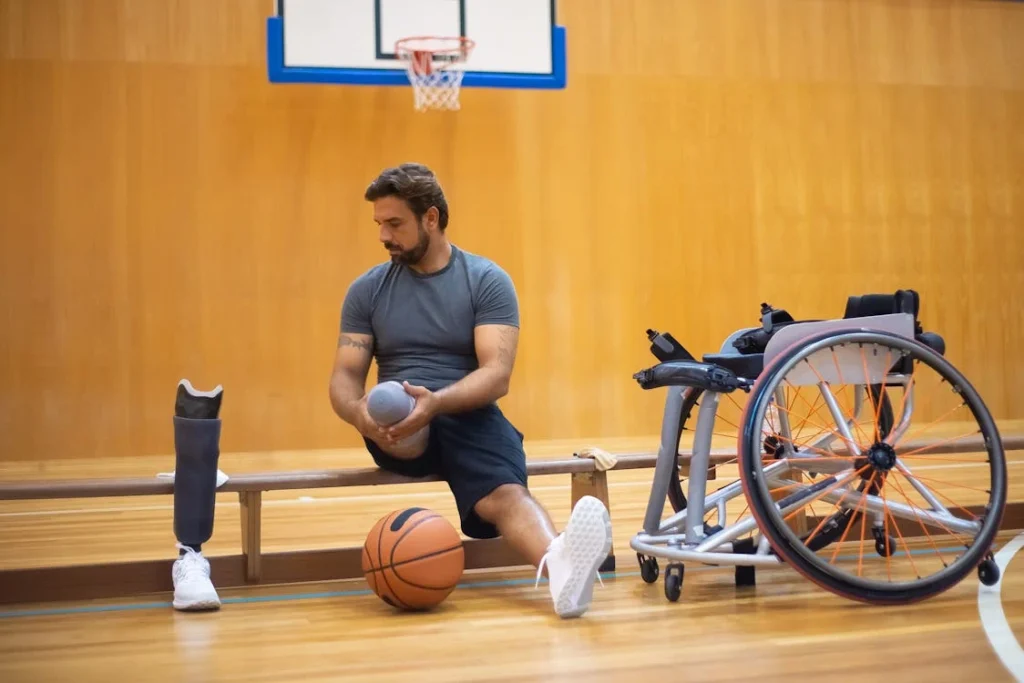After an amputation, recovery isn’t just about surgery, prosthetics, or therapy sessions. There’s a part of healing that often goes unnoticed but makes a big difference—residual limb massage. It may sound simple, even unimportant, but it plays a powerful role in how the body adjusts, heals, and prepares for the next chapter.
The residual limb, sometimes called a stump, goes through a lot in the weeks and months after surgery. It swells. It stiffens. It forms scar tissue. And it often hurts. While medications and prosthetics help, the body also needs hands-on care to calm down, release pressure, and stay healthy over time.
That’s where massage comes in—not as a luxury, but as a smart, gentle tool for recovery. At Robobionics, we’ve seen firsthand how a well-cared-for residual limb leads to better prosthetic fit, less pain, and faster return to daily life. We believe this kind of care should be part of every recovery plan.
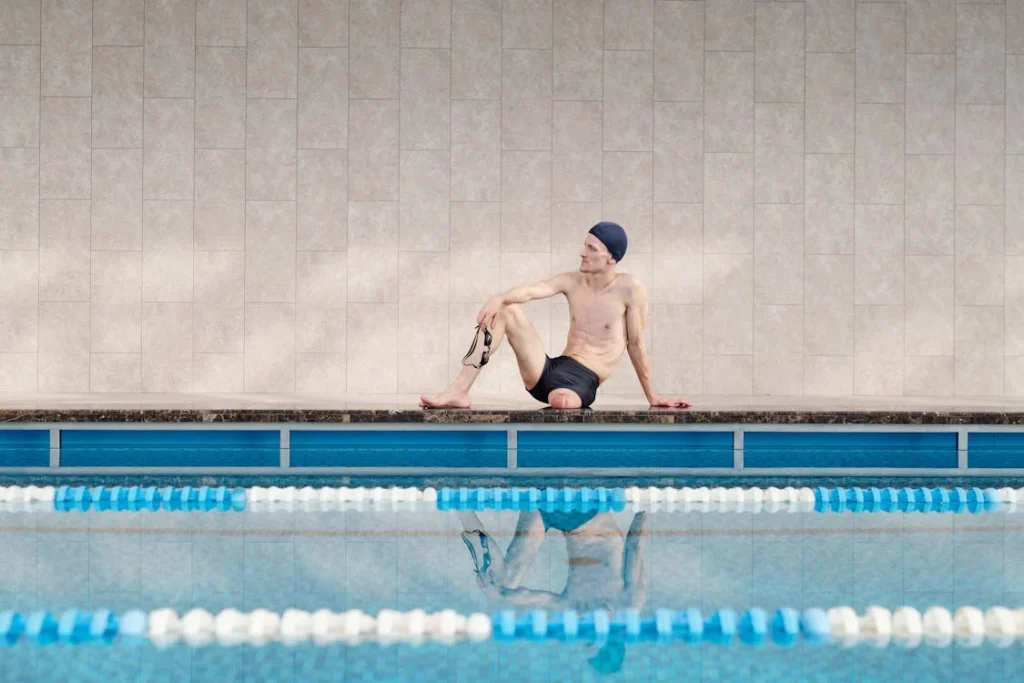
Why the Residual Limb Needs Special Attention
More Than Just What’s Left Behind
When a limb is removed, it’s not just the visible part that changes. Beneath the skin, muscles are cut, nerves are trimmed, blood vessels are sealed, and bones are reshaped.
The area becomes sensitive, swollen, and prone to stiffness. The body is trying to adjust to this new shape and new set of needs.
This isn’t just a wound—it’s the beginning of a lifelong relationship between you and your residual limb.
That’s why caring for the residual limb isn’t optional. It’s essential. Just like brushing your teeth or stretching sore muscles, this part of your body needs daily attention to stay comfortable and functional.
And massage offers a simple but powerful way to keep things moving in the right direction.
What Happens After Surgery
Right after surgery, the body goes into repair mode. Blood rushes to the area, carrying nutrients to help tissues heal. At the same time, fluid starts to build up.
This is a normal part of the process, but it can also become a problem if it’s not managed. This is when swelling begins—and if it lasts too long, it can cause pain, delay healing, and make the limb harder to fit with a prosthetic.
At this early stage, massage must be gentle and guided by a healthcare professional. But as time goes on, it becomes something you can learn to do yourself.
A few minutes a day, done correctly, can reduce swelling, break down tight tissue, and improve blood flow. It’s not magic—but it feels close when done consistently.
The Role of Nerves and Sensation
After an amputation, the nerves that once traveled into the missing part of the limb don’t just disappear. Many of them are still active. Some heal smoothly, while others may misfire or form painful bundles called neuromas.
This is why some people experience phantom limb sensations—the feeling that the missing part is still there. Sometimes these sensations are mild, but sometimes they’re sharp, stabbing, or deeply uncomfortable.
Massage helps by calming the nervous system. When you touch and move the residual limb gently, you send messages to the brain that say, “This area is safe. This area is okay.”
Over time, this can reduce the intensity of phantom pain and help your brain map the new shape of your body.
In a way, massage helps retrain your nervous system. It doesn’t always eliminate pain completely, but it can change how your body experiences it—and that alone can be life-changing.
Scar Tissue: The Invisible Challenge
Scar tissue forms any time the skin and deeper layers of tissue are injured. It’s the body’s way of patching things up quickly.
But unlike regular tissue, scar tissue is tougher, tighter, and less flexible. When it forms around a joint, a nerve, or the site where a prosthetic fits, it can create pressure, stiffness, and discomfort.
Left alone, scar tissue can pull on nearby muscles, limit motion, or create small lumps that make prosthetic use difficult. This doesn’t happen to everyone, but when it does, it can be frustrating—and sometimes painful.
Massage helps soften and stretch scar tissue. Over time, it encourages the fibers to line up in a smoother, more organized way.
This doesn’t make scars disappear, but it can make them more flexible, less painful, and better suited for daily life.
Massaging scar tissue isn’t about rubbing it raw. It’s about consistent, careful pressure—just enough to wake up the tissue and get it moving. Done right, it can help prevent tightness from turning into long-term problems.
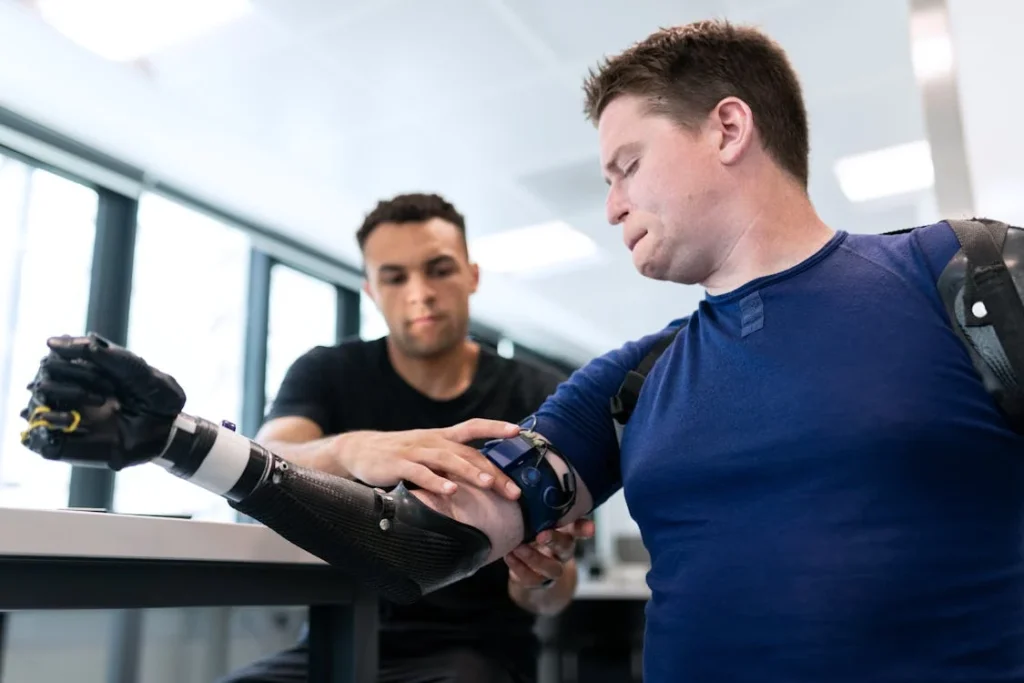
How Residual Limb Massage Helps With Swelling, Pain, and Scar Tissue
Reducing Swelling: Helping Fluids Flow Again
Swelling, or edema, is one of the first challenges after amputation. It’s uncomfortable, it can make your limb feel heavy or tight, and it slows down the healing process.
When fluid builds up, it puts pressure on the skin and underlying tissues. That pressure can increase pain, stretch the skin, and even interfere with wound healing.
Massage helps by guiding this trapped fluid back into the body’s drainage system. This isn’t deep, forceful massage. It’s slow, rhythmic, and light—often called lymphatic massage.
It works with the body’s natural flow to move excess fluid away from the swollen area and back toward the heart, where it can be processed and removed.
When done correctly and regularly, this kind of massage can reduce puffiness and improve comfort. People often notice their limb feels “lighter” afterward, and the skin may appear less shiny or tight.
This makes it easier to wear compression garments, manage bandages, or eventually fit into a prosthetic socket.
This simple act of encouraging flow also brings in more oxygen and nutrients to the healing tissues. That means less inflammation, better recovery, and improved circulation over time.
Managing Pain With Gentle Pressure
Pain after amputation comes in many forms. Some of it is sharp and sudden. Some is dull and persistent. There’s surgical pain, nerve pain, muscle tightness, and sometimes phantom limb pain.
Each type feels different, but they’re all connected by one thing—your body is on high alert.
Massage helps bring the body back down. It tells your nervous system, “You’re safe now.” The act of rubbing the skin and underlying tissue stimulates your touch receptors, which send calming signals to your brain.
These signals can interrupt pain messages, at least for a while. This is called gate control theory, and it’s one of the reasons massage can be so effective for managing discomfort.
Even if the pain doesn’t go away completely, massage helps make it more bearable. It allows your muscles to release, your breath to slow, and your mind to relax.
That change in sensation gives you more control. It gives you the chance to say, “This pain does not own me.”
In the long run, consistent massage can reduce sensitivity in the residual limb. It can make contact with clothes, prosthetics, or even just air feel less intense.
That shift can be the difference between enduring your day and truly living it.
Breaking Down Scar Tissue, One Touch at a Time
Scar tissue forms to protect, but it doesn’t always behave. When it builds up in thick, tight layers, it can trap nerves, pull on the skin, or limit movement.
This is especially tricky around a joint or at the tip of a residual limb, where you need flexibility and comfort to use a prosthetic.
Massage helps keep scar tissue soft and pliable. It encourages the fibers to move and stretch in the same direction, which reduces clumping and improves texture.
Over time, the scar becomes flatter, more mobile, and less noticeable—not just in appearance, but in sensation.
This doesn’t mean pressing hard or trying to break the scar apart. That can actually make things worse. What works is gentle, repetitive motion over time.
Think of it as training the tissue, not fighting it. You’re showing your skin how to move again.
Massaging around the scar also brings in blood flow, which is essential for delivering nutrients and keeping the area healthy.
A well-fed scar is less likely to become painful or irritated, especially under the pressure of a prosthetic socket.
If you start early—once the wound is closed and your doctor says it’s safe—scar massage can prevent problems before they begin.
If you start later, it can still help. The body is always ready to respond to care, no matter how long it’s been.
Preparing the Limb for Prosthetic Use
A prosthetic socket must fit well to work properly. That means your residual limb needs to be stable, consistent in shape, and not overly swollen or tender.
Massage supports all of this. It shapes the soft tissue, reduces excess fluid, and keeps the skin healthy and flexible.
Think of massage as part of your socket preparation routine. It’s just like brushing your teeth before a dentist appointment—you’re making sure everything is clean, healthy, and ready to go.
The more care you give your limb, the better your prosthetic experience will be. A well-massaged limb is less likely to get sores, more likely to tolerate pressure, and quicker to adapt to changes in activity or socket design.
This kind of preparation isn’t just physical. It’s mental too. When you take the time to care for your residual limb each day, you build confidence. You feel more connected to your body.
That confidence shows up when you walk into a prosthetist’s office, when you try a new movement, and when you look in the mirror and think, “I’m doing this.”
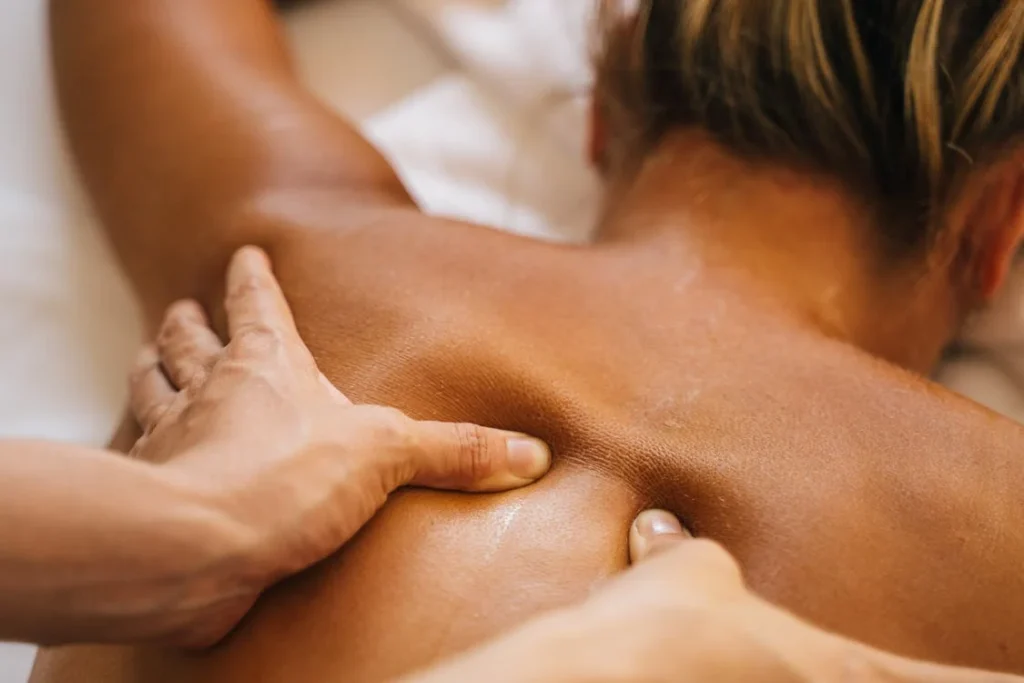
How to Begin Residual Limb Massage at Home
Starting Small and Building Comfort
If you’ve never massaged your residual limb before, the idea can feel strange or even uncomfortable. That’s okay.
In the beginning, it’s normal to feel unsure about touching the area, especially if there’s still tenderness or emotional sensitivity.
Start slow. The goal isn’t to get it “perfect”—it’s simply to connect with your body again, one gentle step at a time.
Begin by resting your limb on a soft surface. A cushion or rolled towel under the limb can help support it so that your muscles can fully relax.
Wash your hands before starting, and make sure the skin is clean and dry. If you’re using lotion or oil, choose one that’s fragrance-free and gentle on healing skin.
Your first sessions don’t need to last more than a few minutes. Light circular movements, soft strokes from the end of the limb toward the body, and gentle pressure are more than enough to start with.
Pay attention to how your limb reacts. Does it feel sore? Does the skin turn red quickly? Does it bring you comfort or make you tense? These are all signals. The more you listen, the better you’ll get at adjusting your touch.
This early connection is about trust—between your body and your brain. As you become more confident, you’ll notice the tension start to melt away. What felt scary before starts to feel soothing.
When to Massage—and When to Pause
Massage is most helpful when the skin has fully healed and there are no open wounds. If you’re fresh out of surgery or have stitches, staples, or visible scabs, wait.
Always follow your surgeon’s or doctor’s advice before starting any hands-on therapy. Once you get the green light, you’re good to go.
A good time to massage is after a shower or warm compress, when the skin and muscles are relaxed. The warmth helps increase circulation and softens the tissue. This makes the massage more effective and more comfortable.
If your limb is sore from wearing a prosthetic or feels tight after a long day, that’s another good moment to use massage. It’s a great way to unwind at the end of the day and help the body reset for the next.
However, avoid massage if your skin is irritated, if you have a rash, or if you feel sharp pain when touching a certain area.
Stop if you feel dizzy, unusually cold, or unwell. Massage should never feel forceful or punishing—it should always support healing, not fight against it.
Using Massage to Connect, Not Just Correct
It’s easy to think of massage as a task. Something you “should do” to avoid swelling or stiffness. But it’s more than that. It’s an act of connection.
When you massage your residual limb, you’re not just softening tissue—you’re rebuilding a relationship with your own body. And for many people, that’s one of the hardest parts after amputation.
You might feel angry at your limb. You might feel disconnected or even repulsed by the way it looks or feels. These emotions are real and valid.
But they also shift over time—especially when you begin to care for the area with consistency and patience.
Each time you place your hands on the limb, you’re saying, “I’m here for you.” That message matters. It brings peace. It builds self-respect.
And it helps calm the mental and emotional noise that often lingers long after the surgery is done.
Massage, then, becomes a daily ritual—not a chore, but a check-in. A time when you slow down, breathe, and remember that healing isn’t just about moving forward—it’s also about reconnecting with where you are right now.
Helping a Loved One With Limb Massage
If you’re a caregiver or family member supporting someone after amputation, learning to offer gentle massage can be one of the most meaningful gifts you give.
But it must be done with care, consent, and good communication.
Start by asking. Not everyone is ready to be touched, even by someone they trust. Respect that. If they agree, go slow. Let them guide the pressure, the pace, and when to stop.
Use soft hands, and focus more on comfort than technique. Even if you’re not a professional, your presence and touch can be incredibly soothing.
You’re not just helping with swelling or scar tissue—you’re reminding them that they’re not alone. That kind of support goes deeper than muscle. It reaches the heart.
Massage becomes a shared moment. A time to connect without words. A way to support healing not just physically, but emotionally too.
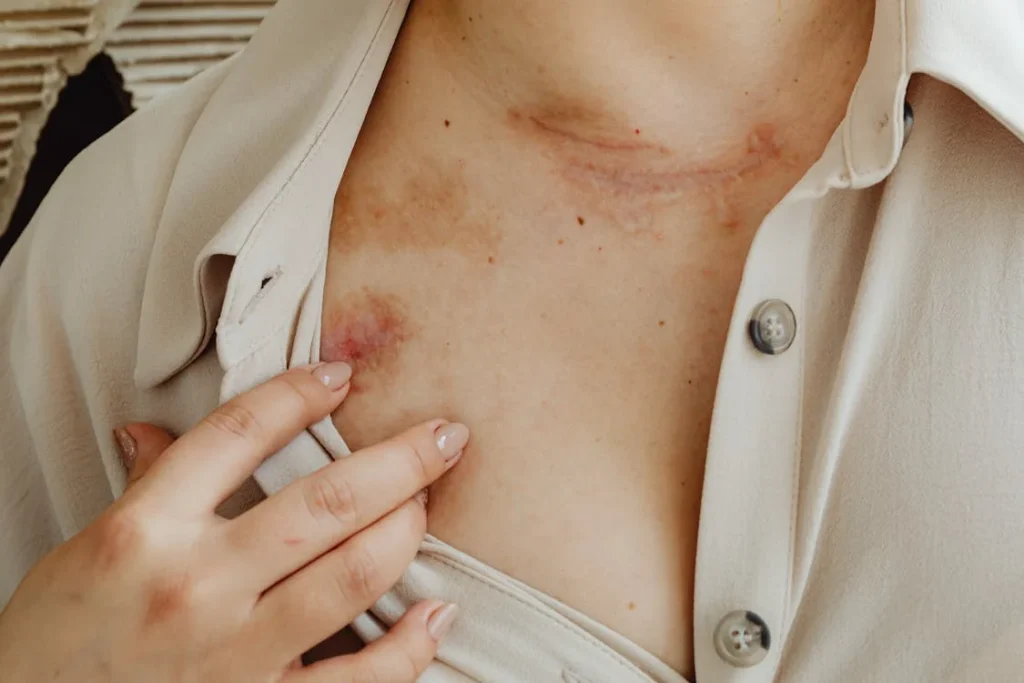
Healing Through Touch: The Emotional and Mental Power of Residual Limb Massage
Touch as a Bridge to Emotional Healing
After an amputation, the emotional impact often hits harder and lasts longer than the physical pain.
You’re not just dealing with the loss of a limb—you’re navigating a new identity, a changing body, and the often silent weight of grief.
Many people describe feeling disconnected from their own body, like something vital has been taken away—not just in form, but in familiarity.
Massage, when introduced gently and mindfully, helps bridge that gap.
Touch is one of the most primal forms of communication. It’s how we’re comforted as children, how we express care without words, and how the body learns what is safe and familiar.
When you massage your residual limb, you’re not just reducing swelling or relaxing muscles—you’re telling your nervous system, “This body is still mine. This body is still whole in its own way.”
Even if you don’t consciously feel this connection at first, over time, it builds. Each moment of touch, even the simplest, starts to stitch together the emotional distance many amputees feel from the part of themselves that’s changed.
Reclaiming Control Over a Changed Body
One of the deepest emotional wounds after amputation is the feeling of lost control. You didn’t choose the surgery. You didn’t ask for the pain.
You may feel like things happened to you, rather than with you. That sense of helplessness often lingers—even long after the wound has closed.
Residual limb massage can become a small but powerful way to take back control. You decide when it happens. You decide how it feels.
You decide how much or how little to do. In a process where so many things have been dictated by doctors, schedules, and circumstances, this act of self-care puts choice back into your hands.
Control doesn’t always mean big decisions. Sometimes, it lives in the quiet things—like five minutes of massage before bed, or the choice to care for your body not because someone told you to, but because you chose to.
That subtle shift can change your mindset from surviving to living. From reacting to owning.
Reducing Anxiety Through Repetitive, Grounding Action
Massage has a calming effect on the nervous system. When done with slow, even movements, it activates the parasympathetic system—what’s often called the “rest and digest” mode.
This slows the heart rate, deepens the breath, and reduces the constant hum of tension that many people carry after trauma.
For those struggling with anxiety, PTSD, or fear after amputation, massage becomes a grounding tool. It offers a predictable rhythm, a familiar touch, a daily ritual that says, “I am here. I am safe.”
The repetition of movement gives the mind something to focus on. It pulls you away from racing thoughts and into the present moment, one breath at a time.
Over time, massage can become part of your emotional toolkit. Not just something you do for swelling or scars, but something you reach for on hard days.
When the world feels overwhelming, when you need comfort but don’t know where to turn—your own touch can guide you home to yourself.
Encouraging Body Acceptance, One Touch at a Time
Looking at or touching a limb that feels “incomplete” is not easy. Many amputees struggle with their self-image, especially in a society that often defines beauty and strength in very narrow ways.
The residual limb can feel foreign, flawed, or something to hide.
Massage offers a new narrative. A new way to see and feel the limb—not as broken, but as brave. Not as something to ignore, but as something to care for.
Each time you run your hand over the skin, each time you apply lotion with intention, you’re building acceptance. Not forced, not rushed—just slowly, honestly.
You don’t have to love every part of your body to care for it. You just have to show up. And in showing up, day after day, healing happens. Not just in the tissue, but in the heart.
Massage becomes an act of radical kindness. A declaration that this body—your body—is still worthy of care, attention, and love.
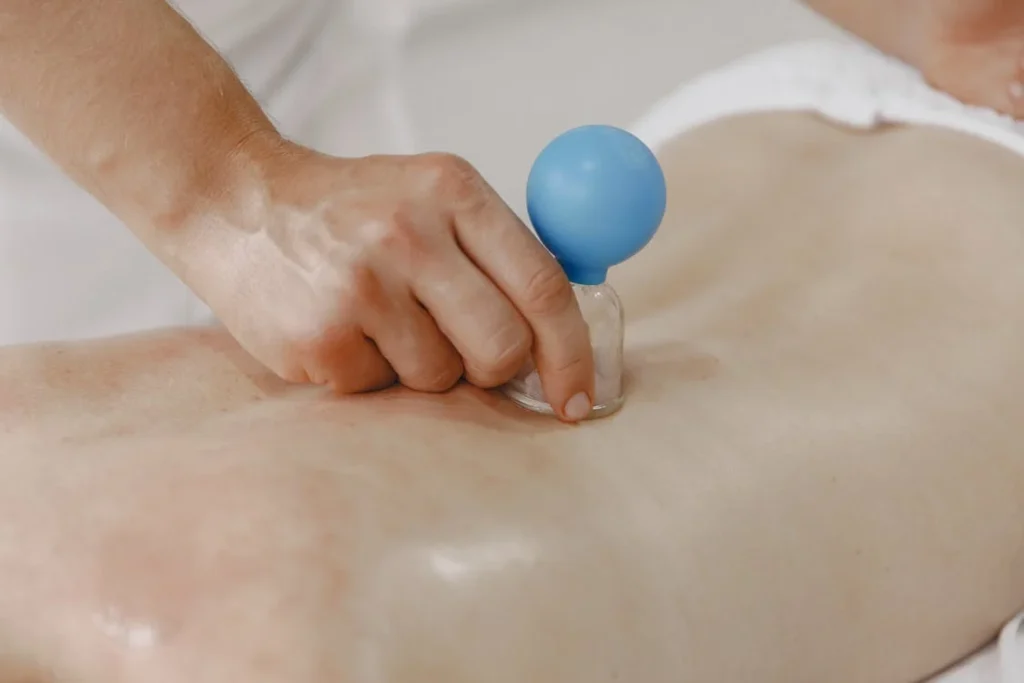
Adapting Over Time: Massage as a Long-Term Tool for Prosthetic Success
The Residual Limb Is Always Changing
Many people assume that once the wound from amputation heals, everything becomes stable. But in reality, the residual limb keeps changing—especially during the first year, and often beyond that.
As swelling goes down, as muscles adapt, and as scar tissue shifts, the shape and feel of the limb evolve. This means that what fit comfortably yesterday might feel tight or awkward today.
This is one of the most common reasons why prosthetic sockets feel uncomfortable over time. It’s not just about the prosthetic itself—it’s about how your limb is changing underneath it.
Residual limb massage helps smooth this transition. By promoting healthy circulation, reducing inflammation, and keeping tissues supple, massage supports a more predictable and consistent limb shape.
This can reduce the number of times you need socket adjustments and lower the risk of pressure points or skin irritation.
Massage won’t stop your limb from changing—that’s part of the body’s natural adjustment. But it can help guide those changes in a healthier, more manageable direction.
Daily Massage as Part of the Prosthetic Routine
Just like you clean your prosthetic, charge your myoelectric arm, or adjust your liners, massage can become a regular part of your daily limb care routine. And it doesn’t have to be time-consuming or complicated.
A quick session in the morning can help “wake up” the tissues before you put on your socket. This helps stimulate blood flow and reduce morning stiffness, especially if you sleep in one position most of the night.
A light massage in the evening can help release tension from the day, especially if you’ve been active, walking, or standing for long periods.
This daily attention helps prevent skin breakdown, a common issue for long-term prosthetic users. If your limb is sore, tight, or tender, you’ll notice it earlier during massage than you would just going about your day.
That awareness allows you to adjust quickly—maybe by adding an extra sock layer, taking breaks more often, or calling your prosthetist before a small problem becomes a serious one.
Massage gives you a real-time way to check in with your limb—how it feels, how it’s changing, and what it needs. That self-awareness can drastically improve your long-term comfort and prosthetic experience.
Preventing Socket Discomfort Through Soft Tissue Management
Even a well-made socket can feel harsh if the limb inside it is tense, inflamed, or scarred. Soft tissue—the skin, fat, muscle, and connective layers—plays a major role in how pressure is absorbed and distributed within the socket.
When that tissue is tight or stiff, pressure builds up in one spot. That’s where pain, bruising, or sores start to form.
Massage helps by keeping that soft tissue mobile and responsive. It teaches the tissues how to handle daily loading and unloading.
It promotes elasticity so that skin moves with the socket instead of resisting it. And it helps prevent adhesions, where tissues stick together in a way that causes pulling or pinching.
This is especially useful when you transition between different prosthetics—for example, from a temporary socket to your permanent one, or from a walking aid to a more advanced model.
Your limb will always need time to adjust, but massage can shorten that time by reducing tissue resistance and helping the body adapt more easily.
You’re not just preparing your body for the prosthetic—you’re also preparing your prosthetic to work better with your body.
Supporting Long-Term Limb Health
As time passes, long-term amputees may experience issues like uneven wear on the residual limb, poor circulation, changes in tissue density, or the buildup of hard scar bands that interfere with comfort.
These changes don’t happen overnight—they build up slowly over months or even years.
Incorporating massage into your long-term care plan is like doing regular maintenance on a machine you rely on every day. You may not see dramatic results right away, but over time, the benefits add up.
You reduce your risk of complications. You maintain more consistent comfort. You stay in tune with how your body is evolving.
For many prosthetic users, this kind of care helps extend the life of their sockets, reduce the need for frequent adjustments, and stay more active without fear of injury or breakdown.
Massage, in this sense, is more than recovery. It’s protection. It’s what keeps you moving—not just today, but five, ten, or twenty years from now.
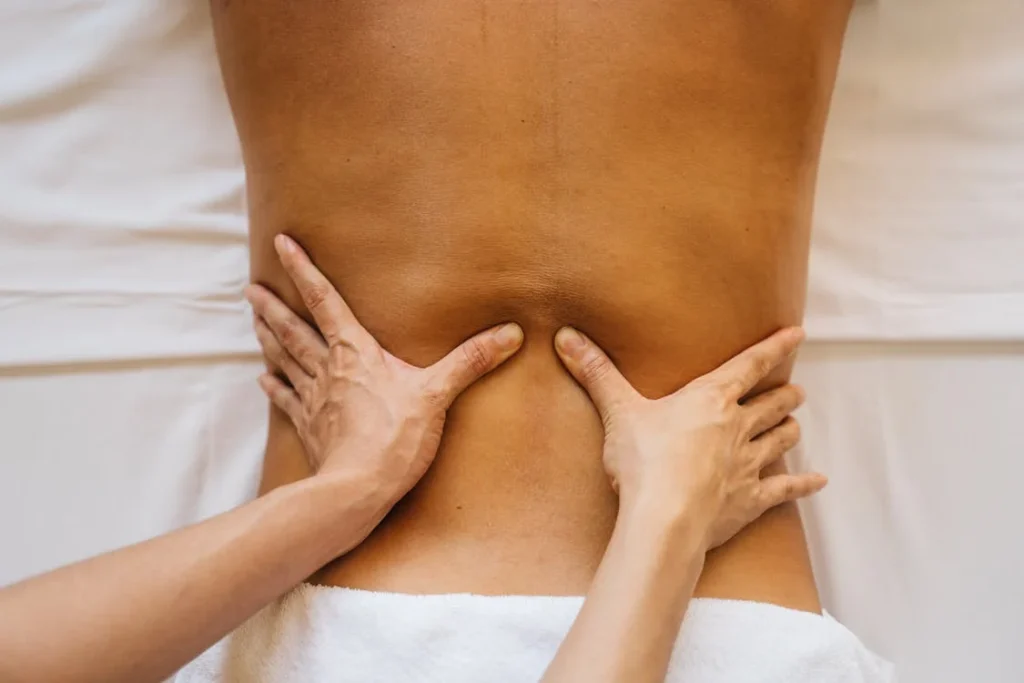
Making Residual Limb Massage Part of Your Life
More Than a Technique—A Daily Act of Self-Respect
By now, it’s clear that residual limb massage isn’t just a recovery trick or a one-time step. It’s a practice that grows with you.
From the early days of healing to your long-term journey with a prosthetic, massage supports your comfort, mobility, and peace of mind.
What makes this practice powerful isn’t just the science—it’s the meaning behind it. Every time you take a few minutes to massage your limb, you’re choosing to care for yourself.
You’re saying, “This body, even in its new form, is worthy of attention. It’s worthy of respect. It’s still mine.”
That’s not always an easy thing to believe, especially after the trauma and grief that come with amputation. But healing is not about rushing or reaching perfection. It’s about showing up—gently, patiently, and consistently.
Massage won’t solve every issue. It won’t erase pain overnight or stop every change from happening. But it will give you more control, more comfort, and more connection.
It will make your prosthetic experience smoother. It will help you understand your own body better. And over time, it can become something that brings you not just relief—but pride.
Start where you are. Go at your own pace. And know that every touch is a step forward.
Conclusion
Residual limb massage is not a luxury. It’s a vital, simple, and powerful part of amputation recovery and prosthetic success. It reduces swelling, eases pain, softens scar tissue, and supports your emotional and mental well-being. Whether you’re just beginning to heal or you’ve been living with a prosthetic for years, it’s never too late to start.
At Robobionics, we believe in whole-person care. We build prosthetics that move with you, but we also champion the tools that help you feel good in your body every single day. Residual limb massage is one of those tools—grounded in science, driven by care, and powered by you.
This journey is yours. Let massage be one of the ways you walk it with strength, dignity, and self-respect.



